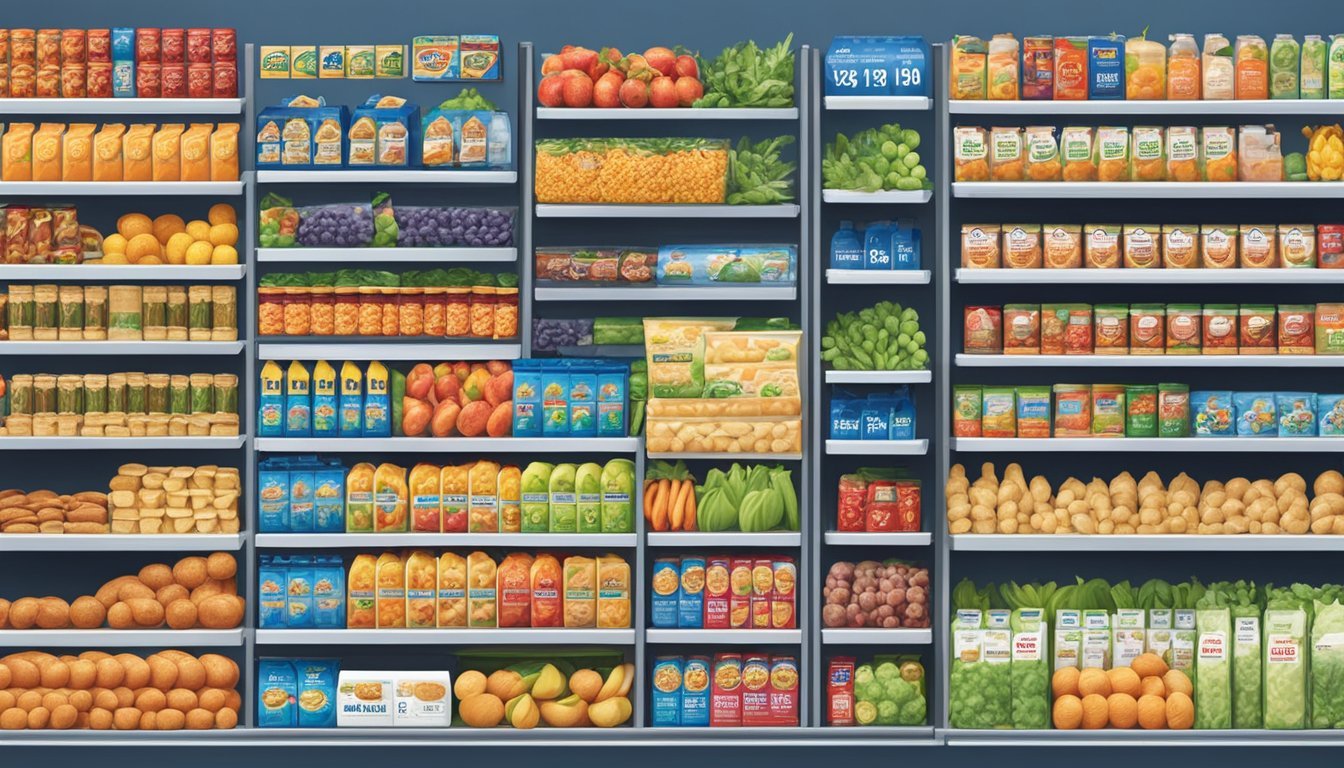Is Aldi Cheaper Than Hannaford?
Comparing Grocery Prices in 2024
Grocery shopping can be a significant expense for many households. Comparing prices between different stores is a smart way to stretch your budget. Two popular grocery chains, Aldi and Hannaford, often compete for customers' attention.
Aldi typically offers lower prices than Hannaford on many grocery items. This German-based discount retailer is known for its no-frills approach and focus on private label products. Hannaford, a regional supermarket chain in the northeastern United States, provides a wider selection of products and services.
Price-conscious shoppers may find substantial savings at Aldi, especially on staple items and packaged goods. However, Hannaford can be competitive on certain products, particularly fresh produce and meats. A thorough price comparison between the two stores can help shoppers determine which retailer best suits their needs and budget.
Understanding Grocery Store Pricing
Grocery store pricing involves complex factors that influence the cost of products on shelves. These factors shape the pricing strategies of different chains and impact consumer choices.
Price Determinants in Grocery Chains
Grocery chains consider various elements when setting prices. Supply chain efficiency plays a crucial role, with stores like Aldi optimizing their logistics to reduce costs. Store size and layout also impact pricing, as smaller formats often lead to lower overhead expenses.
Location affects pricing too. Urban stores may have higher rent and labor costs, potentially raising prices. Rural stores might face increased transportation costs.
Inventory management influences pricing. Stores that minimize waste through accurate forecasting can offer lower prices. Some chains use dynamic pricing, adjusting costs based on demand and competition.
Quality and Price Correlation
The relationship between quality and price in grocery stores is not always straightforward. Higher prices don't necessarily guarantee better quality, and lower prices don't always indicate inferior products.
Some stores focus on offering premium, organic, or locally-sourced items at higher price points. Others, like discount chains, may provide good quality at lower prices by reducing overhead costs.
Store layout and presentation can affect perceived quality. Well-organized displays and attractive packaging may justify higher prices in consumers' minds.
Store Brands vs. National Brands
Store brands, also known as private labels, often offer significant savings compared to national brands. Supermarkets can price these items lower due to reduced marketing costs and direct control over production.
Quality of store brands has improved over time. Many chains now offer tiered private label lines, including premium and organic options.
National brands typically have higher prices due to marketing expenses and brand recognition. However, they often lead in product innovation and consistency across different stores.
Some consumers perceive national brands as superior, while others find store brands equally satisfactory. The choice between them can significantly impact a shopper's grocery bill.
Comparative Analysis of Aldi and Hannaford
Aldi and Hannaford employ distinct strategies to attract customers and offer competitive pricing. Their differing business models and market positions impact grocery costs for shoppers.
Aldi's Business Model
Aldi focuses on a no-frills approach to keep prices low. The store stocks a limited selection of primarily private-label products. This reduces overhead costs and allows for bulk purchasing.
Aldi's stores are smaller than traditional supermarkets. They use efficient shelf-stocking methods and a cashier-only checkout system. Customers bag their own groceries and must bring or purchase bags.
The company emphasizes value over variety. While shoppers may find fewer options, Aldi's prices are often significantly lower than competitors. This appeals to budget-conscious consumers looking to reduce their grocery bills.
Hannaford's Market Position
Hannaford positions itself as a full-service supermarket with a wider product range than Aldi. The chain offers both national brands and its own private-label items.
Hannaford stores are typically larger and provide amenities like in-store pharmacies and delis. This caters to customers seeking one-stop shopping convenience.
The company emphasizes fresh produce and high-quality meats. Hannaford also stocks organic and specialty items. This diverse selection aims to attract a broader customer base, including health-conscious shoppers.
Price Comparison Methodology
To accurately compare prices between Aldi and Hannaford, a standardized approach is crucial. Researchers often use a "market basket" method.
This involves selecting a fixed list of common grocery items. The basket may include staples like milk, eggs, bread, and produce. Prices for identical or equivalent products are recorded at both stores.
Researchers calculate the total cost of the market basket at each retailer. They may also compare individual item prices. This method provides a clear picture of overall savings potential.
It's important to note that prices can vary by location and time of year. Regular price checks and averaging over time yield more reliable results. Some studies also factor in the cost of travel to each store for a comprehensive comparison.
Assessing Cost of Staples
A comparison of staple grocery items between Aldi and Hannaford reveals notable price differences. The analysis covers common products, produce, and meats to provide a comprehensive view of potential savings.
Price Analysis on Common Grocery Items
Aldi often offers lower prices on many everyday staples compared to Hannaford. Milk, a household essential, tends to be cheaper at Aldi by an average of 15-20%. Eggs also show significant savings, with Aldi's prices frequently 10-25% less than Hannaford's.
Yogurt prices can vary, but Aldi's store brands are typically priced 20-30% lower than national brands at Hannaford. However, when Hannaford runs promotions on yogurt, the price gap may narrow considerably.
For dry goods like pasta, rice, and cereal, Aldi maintains a consistent price advantage. These items are often 10-15% cheaper than comparable products at Hannaford.
Comparison of Produce Prices
Produce pricing can fluctuate based on seasonality and local availability. Bananas, a popular fruit, are generally priced similarly at both stores, with minimal differences of 1-3 cents per pound.
Aldi's produce prices are frequently lower, especially for staple items like potatoes, onions, and carrots. Savings on these items can range from 10-25% compared to Hannaford.
Seasonal fruits and vegetables may show more significant price variations. During peak seasons, both stores offer competitive pricing, but Aldi often maintains a slight edge of 5-10% on most produce items.
Meat and Deli Cost Evaluation
Meat prices can greatly impact grocery bills. Chicken breast, a versatile protein, is typically 10-20% cheaper at Aldi compared to Hannaford's regular prices. However, Hannaford's frequent meat sales can sometimes beat Aldi's everyday low prices.
Ground beef pricing is competitive at both stores. Aldi usually offers lower prices on their store-brand ground beef, while Hannaford may have better deals on name-brand options.
Deli meats and cheeses are areas where Hannaford often provides more variety. While Aldi's limited selection is priced lower, Hannaford's broader range and periodic sales can attract customers looking for specific brands or cuts.
Consumer Shopping Experience
Aldi and Hannaford offer distinct shopping experiences that cater to different customer preferences. Their approaches to store layout, customer service, and checkout processes shape how shoppers interact with each brand.
Store Layout and Navigation
Aldi stores are typically smaller and more compact than Hannaford locations. Aldi's streamlined layout features fewer aisles and a limited product selection, making navigation straightforward. Products are often displayed in their original shipping boxes to reduce restocking time.
Hannaford stores are larger, offering a wider variety of products and brands. Their layout is more traditional, with clearly labeled departments and wider aisles. This setup allows customers to browse more extensively and find specialty items.
Both chains prioritize cleanliness, but Aldi's minimalist approach often results in a tidier appearance. Hannaford's larger format may require more frequent tidying throughout the day.
Customer Service Quality
Aldi operates with a lean staff model, focusing on efficiency. Employees are cross-trained to handle multiple tasks, which can sometimes limit their availability for customer inquiries. Despite this, Aldi staff are generally knowledgeable about store operations and products.
Hannaford typically offers more personalized customer service. Their stores often have dedicated staff in various departments, such as deli or bakery, to assist shoppers. This approach can lead to shorter wait times for specific queries or requests.
Both chains train their employees to be courteous and helpful, but the level of interaction varies due to their different operational models.
Checkout Convenience
Aldi's checkout process is designed for speed. Cashiers are known for their rapid scanning abilities, and customers are expected to bag their own groceries. This system can lead to shorter queue times but may require more effort from shoppers.
Hannaford offers a more traditional checkout experience. They provide bagging services and often have more checkout lanes open during peak hours. Self-checkout options are also available in many Hannaford stores, giving customers a choice in their checkout method.
Aldi has cultivated a loyal following among budget-conscious shoppers who appreciate the no-frills approach. Hannaford attracts customers who value a broader selection and more conventional grocery store amenities.
Savings and Discounts
Both Aldi and Hannaford offer various ways for customers to save money on groceries. These include regular sales, loyalty programs, and special promotions that can significantly reduce shopping costs.
Regular Sales and Promotions
Aldi features weekly "Aldi Finds" specials on limited-stock items across various categories. These deals often include deep discounts on seasonal products and household goods. Aldi also runs "Red Hot Deals" on select grocery items, which can offer substantial savings.
Hannaford provides weekly flyer deals and digital coupons accessible through their website and mobile app. They frequently offer "Great Values" on everyday items and "Buy One, Get One Free" promotions on select products.
Both stores use loss leaders - deeply discounted popular items - to attract customers. These can include staples like milk, eggs, or bread sold at or below cost.
Membership and Loyalty Programs
Aldi does not have a traditional loyalty program. Their business model focuses on consistently low prices for all customers without the need for memberships or cards.
Hannaford offers My Hannaford Rewards, a free program that provides:
2% earnings on store brand products
Personalized coupons based on shopping history
Exclusive member-only deals
Members can accumulate points and redeem them for discounts on future purchases, helping save money on groceries over time.
Coupons and Cashback Offers
Aldi rarely accepts manufacturer coupons, maintaining their streamlined approach to keep prices low. However, they occasionally offer store coupons for specific promotions.
Hannaford accepts:
Manufacturer coupons
Store coupons
Digital coupons loaded to My Hannaford Rewards accounts
Hannaford also participates in cashback apps like Ibotta, allowing customers to earn rebates on certain purchases. This can provide additional savings beyond sale prices and loyalty program benefits.
Both stores offer rain checks for out-of-stock sale items, ensuring customers can still access deal prices when products are restocked.
Specialty Sections and Services
Aldi and Hannaford offer unique specialty sections and services to cater to diverse customer needs. These include health-focused options, prepared meal solutions, and convenient shopping alternatives.
Organic and Health-focused Options
Aldi's SimplyNature line features organic produce and natural products at competitive prices. The store's organic selection has expanded in recent years, offering fresh fruits, vegetables, and packaged goods. Hannaford provides a wider range of organic and health-focused items through its Nature's Place brand. This includes high-quality produce, meats, and dairy products.
Hannaford's organic section is typically larger and more diverse than Aldi's. It often includes specialty items like organic herbs, superfoods, and locally-sourced products. Aldi's organic offerings, while more limited, are generally priced lower than comparable items at Hannaford.
Pre-made Meals and Deli Services
Hannaford excels in prepared foods and deli services. Their stores feature hot food bars, salad bars, and made-to-order sandwiches. Customers can find a variety of pre-made meals, rotisserie chickens, and fresh-cut fruits and vegetables.
Aldi's pre-made meal options are more limited. They offer a small selection of ready-to-heat meals and pre-packaged deli items. While Aldi's choices are fewer, they are often priced lower than similar options at Hannaford.
Online Shopping and Delivery
Both stores have embraced online shopping and delivery services. Hannaford To Go allows customers to order groceries online for pickup or delivery. The service is available at most Hannaford locations, offering a wide selection of products.
Aldi partners with Instacart for grocery delivery options. Customers can order through the Instacart app or website. Aldi's online selection includes most in-store items, but prices may be slightly higher than in-store to cover service costs.
Hannaford's online platform often provides more features, such as digital coupons and personalized recommendations. Aldi's service is straightforward and aligns with their no-frills approach to shopping.
Customer Perceptions and Brand Loyalty
Aldi and Hannaford have distinct customer perceptions and loyalty dynamics. Consumer opinions and research findings reveal key differences in how shoppers view these grocery chains.
Satisfaction Rates and Reviews
Aldi receives high marks for customer satisfaction, with a Retail Feedback Group study showing a 4.27 out of 5 rating. This score puts Aldi close to traditional supermarkets, which average 4.31. Hannaford, while not specifically mentioned in the study, falls under the supermarket category.
Aldi excels in value perception. Customers frequently praise the chain's low prices and quality store-brand products. This combination has helped Aldi build a loyal following among budget-conscious shoppers.
Hannaford, part of the traditional supermarket segment, typically scores well on factors like product variety and customer service. These attributes contribute to its customer retention.
Research Findings on Customer Preferences
Studies show that Aldi's "Like Brands, Only Cheaper" campaign resonated strongly with consumers. 62% of people surveyed recalled seeing the ad, with 84% correctly identifying it as Aldi's. This high brand awareness has bolstered Aldi's position in the market.
Area consumers often compare Aldi and Hannaford prices. A Winsome to Wisdom grocery store price comparison highlighted differences between the two chains, though specific results vary by product and location.
Researchers note a potential growth area for Aldi among younger shoppers. Gen Z currently shows lower brand recognition and usage rates for Aldi compared to other age groups. This presents an opportunity for the chain to expand its customer base.
Conclusion
Aldi emerges as the more budget-friendly option compared to Hannaford for many grocery items. Families looking to save money on their weekly shopping trips can often find lower prices at Aldi.
However, price isn't the only factor to consider. Hannaford offers a wider selection of products and brands. Some customers may prefer Hannaford's produce quality or store layout.
A thorough price comparison reveals that savings vary by product category. Shoppers can maximize their budget by strategically purchasing certain items at each store.
For budget-conscious consumers, mixing shopping between Aldi and Hannaford can yield the best overall value. This approach allows families to benefit from Aldi's low prices while still accessing Hannaford's broader range of options.
Ultimately, the "winner" depends on individual priorities. Those focused purely on cost savings will likely favor Aldi. Customers who value variety may lean towards Hannaford despite potentially higher prices.
Regular price checks and flexible shopping habits can help families optimize their grocery budgets at both stores.








